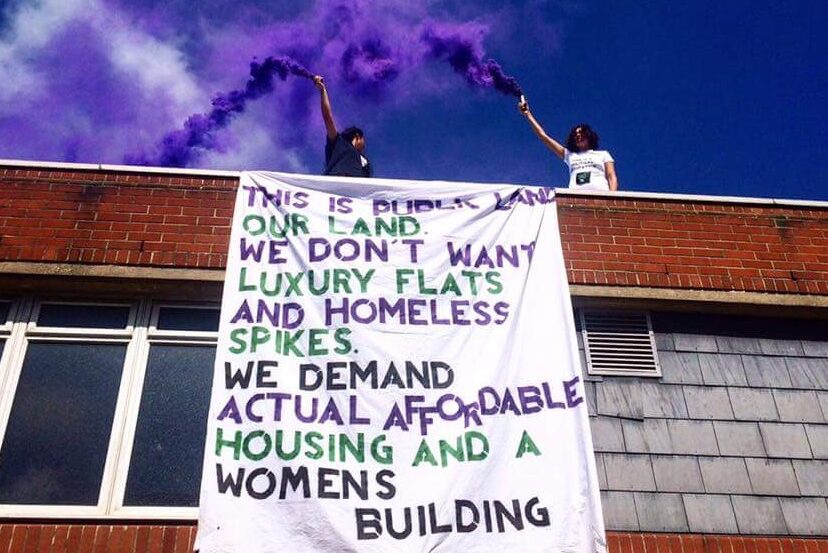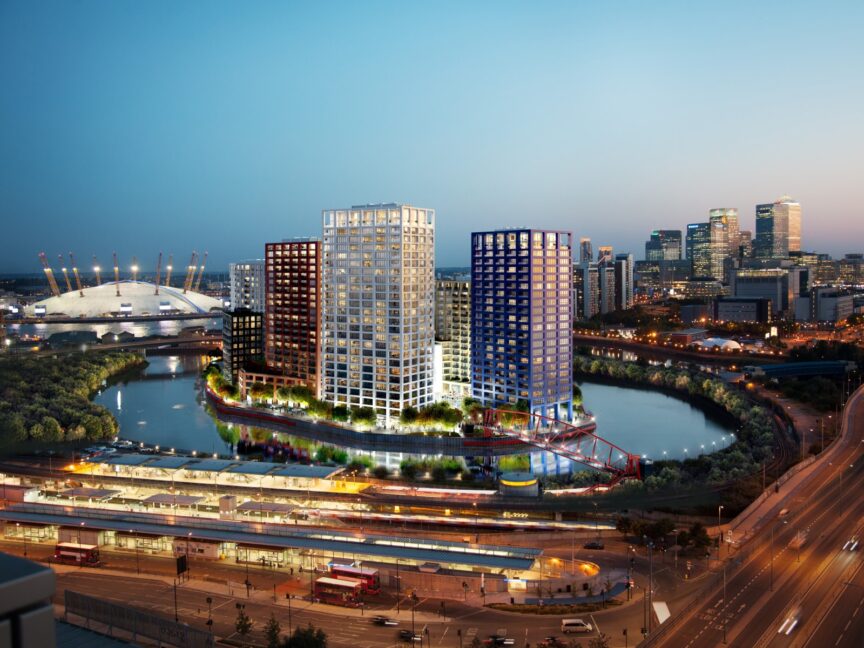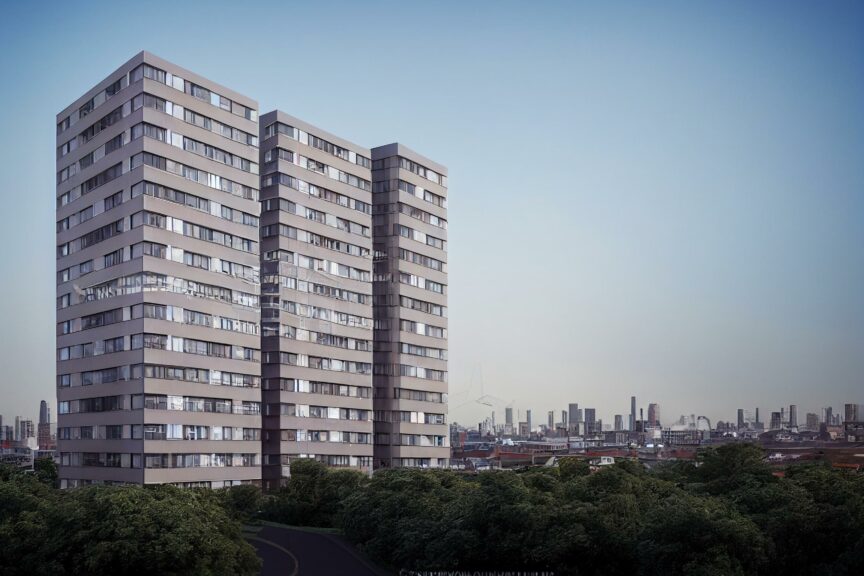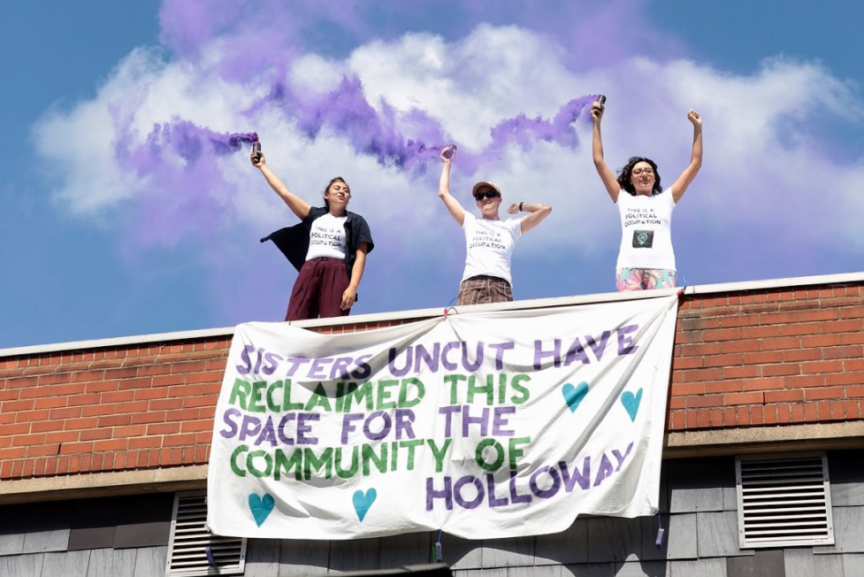How to Make a Home in a Housing Crisis
Political demands expressed through experiments in living can lay powerful foundations.
by Sophie K Rosa
31 March 2023

The same week our landlord threatened me and my friends with eviction, I went to view a luxury London property. Posing as a rich couple, myself and artist-researcher Laura Yuile visited the £3m townhouse as part of her project Asset Arrest: “An estate-agent-agent that handles the process of arranging viewings of properties you have no intention of buying.”
The house we viewed is part of the 12-acre London City Island development in Newham, managed by Ballymore Group – in Laura’s estimation, “among the evilest of the property developers” – in partnership with EcoWorld, a Malaysian developer. The site – not in fact an ‘island’ at all, but a peninsula of the River Lea – was once known as ‘Bog Island’ due to its susceptibility to flooding. The development’s foundations have been built using earth dug up for multi-storey subterranean extensions in Kensington mansions. Like many other property developers, Ballymore purports to be engaged in ‘regeneration’. That is to say: building expensive flats in poor areas and pricing out established populations – in this case, selling many properties ‘off-plan’ to non-resident investors.
There is little incentive to design and construct to high standards when every corner cut means more money in directors’ pockets. Ballymore is also notorious for squeezing every penny of profit possible out of residents in additional charges – including, in one case, charges for renovations after a fire in one of their towers, which the London Fire Brigade said acted like a ‘broken chimney’ due to a faulty ventilation system. Laura once overheard some site engineers agreeing that, even if they had the money, they would never buy a Ballymore home.

Before viewing the house, Laura and I got into character in the development’s ‘Homestead’ restaurant, eating truffle oil chips and drinking gin and tonics. Then we met our assigned salesperson, James, who handed us gulp-sized plastic bottles of water with a peroxide grin.
Though James was probably younger than me – and could also, no doubt, not afford such real estate – I felt childlike being shown around the house. With London home ownership, let alone luxury home ownership, so out of reach, I felt my impersonation of someone for whom it wasn’t must have been transparent. I let Laura – experienced at the guise – do most of the talking. “Is that a walk-in wardrobe?”, she asks. “Yes, it’s huge”, replies James, “the size of most people’s studio flats!”
Bookable via a ‘concierge app’, the development’s amenities – the pools, the spa, the gyms, the cinema, the workspace, the art galleries – are open to all and great places to make friends, James says, assuring us that “members of the public are not allowed in”. This includes those living in the development’s small proportion of ‘affordable housing’.
What London City Island is really ‘about’, says James – echoing the marketing copy’s keywords – is ‘close-knit’ and ‘creative’ community. When planning the development, Ballymore contracted Futurecity, “a global cultural placemaking agency”. The consultants were tasked with building a ‘cultural strategy’: inventing a simulacrum of artsy neighbourliness to attract buyers. Cultural institutions were lured in: the National Ballet has relocated there, and the developers had been trying to ‘get’ the London Film School, James tells us, but they pulled out. Ballymore has also tried to attract small independent artists – some ‘quite famous’, apparently. When Laura rented an art studio in the development, she was told to tidy it up by site managers, in case the messy creative space, visible through her window, was off-putting for prospective investors.
On the review website Trustpilot.com, Ballymore residents complain of low-quality, unsafe builds; disrepair; exorbitant and uncapped service charges; and poor communication from the ‘monopolistic’ company. Senior Ballymore staff have responded to this by drowning out bad reviews with their own five-star ones, leading Trustpilot to issue a ‘cease and desist’ letter.
Developers like Ballymore don’t intend to sell well-built homes at reasonable prices; instead, they flog an idea of home. In the case of London City Island, this idea amounts to “an urban warehouse aesthetic” set in “a hub for creative minds”, “designed to improve wellbeing and socialisation”. Unlike sturdy construction, concepts require minimal investment: hire a ‘placemaking’ consultant to fabricate an ethos; build a shop-front website to masquerade as an arts blog; print a glossy brochure pretending to be a culture mag; lure in some creative types with impossible-to-refuse rents.
A couple of weeks after our visit, Laura attended a conference for developers held on London City Island called ‘Productive Placemaking: New Opportunities – What does successful urban regeneration truly look like?’ During the networking time, a developer told Laura’s architect persona of his regeneration project: “We really tried to manufacture a sense of life and in some ways, it paid off.” Another developer, a Ballymore director, confessed: “Yes, ultimately we have the sinister goal of increasing property prices, but it doesn’t mean we don’t care about culture!” Newham, where Ballymore built London City Island, is one of London’s poorest boroughs. Compared to London averages, the borough has much higher rates of child poverty and homelessness, and the highest rates for evictions and households in temporary accommodation. In recent years, rent in the area has risen twice as fast as wages.

‘Home’ can mean many things – but, at the very least, feeling ‘at home’ requires some sense of security. Security in feeling, for instance, that you have a safe place to settle, a place that you can ‘make your own’, where you won’t be forced to leave. In the UK, unless you inherit or can afford to buy a home, this sense of security is very hard to come by.
In the UK today, the logic of ‘home’ is configured through the property market, in which people are supposed to invest in ‘assets’, from which they might extract yet more wealth in the form of rent. In this context, hundreds of thousands of people are homeless, whilst there are over 500,000 homes with no permanent resident. Social housing is shoddy and scarce, and not an option at all for those with no recourse to public funds, including many migrants; private sector rents are extortionate, sucking up a third of most tenants’ income, and almost 50% in London; and buying a home is unaffordable for a large proportion of the population due to house prices rising faster than wages. This arid landscape of home – the ‘housing crisis’ – is the result of decades of government policy favouring wealth accumulation for the few, over reliable roofs for everyone. This is no secret to young people: 78% blame capitalism for the housing crisis.
It was only whilst telling everyone to stay at home during a pandemic that the government was forced to introduce measures for (some of) those who couldn’t. Overnight – as if conceding that survival being contingent upon having money was an abusive logic – the Tory government banned evictions and ordered local councils to eradicate rough sleeping. Such measures, whilst flawed, proved that rapid societal transformation is possible. But, of course, they were short-lived: landlords were soon as free as ever to turf tenants out at will; additional support for rough sleepers was scrapped. And whilst the state had some tepid offerings for some rough sleepers and renters, many others deprived of homes were left to suffer the physical and mental burdens of the pandemic under duress, in institutions such as detention centres, prisons and psychiatric hospitals.
For the Tory government, ‘home’ meant a comfortable place, where we most likely lived alongside our most dear and caring companions. And if not, then a place where they were all just a cup of tea and a video call away: the new paragon of homeliness, as pictured by every other pandemic-era ad.
This domestic mythology is based upon the state ’s privileged ideology of home – that of the bourgeois nuclear household. According to this way of organising society, everyone should live much of their lives in homes that they own, ideally in a family made up of a married couple with actual or impending offspring. Many people aspire to this vision. Owning a home is seen as an accomplishment – increasingly, a victory ‘against the odds’. It has become customary for young people with family money to write articles about ‘how I bought my first house at 23’, and for couples to post celebratory homeowner photos on social media, dangling their keys like inedible carrots.
But even at its best, the nuclear or private household is rarely the cosy haven it is touted as. The cultural messaging that glorifies home as a place of relaxation, tenderness and unity might evoke a certain longing – perhaps because, for most of us, it is a fiction.
The state’s preferred model of home-life is not privileged for its likelihood to nurture love and happiness, but for its utility to capital. Organising society into atomised nuclear family units props up the reproduction of workers for capitalism, shores up property relations through marriage and inheritance, and restricts opportunities for solidarity against the state. Private households maximise consumption whilst minimising communality – for example, from the mid-twentieth century, the rise of domestic appliances marketed at women saw a shift away from shared services such as laundrettes.
Many groups are excluded from this limited and limiting vision of home. People without a home or living in a version of home other than the capitalist ideal are maligned and disciplined or deprived of housing altogether as a punishment for alterity. Drug users are routinely excluded from shelters; queer and trans people struggle to find safe refuge; undocumented migrants face criminalisation if they seek shelter, such as when the homeless charity St Mungo’s colluded with the Home Office to identify migrants for deportation. Meanwhile, rough sleepers face stigma and cruelty for attempting to survive on the streets – especially those who drink alcohol, despite the fact the housed population might think nothing of their own bottle-of-wine-a-night habit, in ‘the privacy of their own home ’.

Contrary to the popular imaginary – in pandemic advertising, in festive imagery, in romantic films – home as we know it is not a source of indiscriminate unity. The nuclear household can foment isolation, crushing the potential of expansive solidarities. And, in the fractures of home, capital percolates, flogging objects designed to pacify us.
In a society where many would-be homes are vacant and many inhabited houses are hollow, we seek solace in empty places. Clothing brands imitate belonging; ‘hygge’ interiors simulate comfort; workplaces adopt a home-like façade of sofas and fruit bowls. Mobile phones can numb us to our dislocation whilst we are in their grip; our scrolling might feel homeward bound. According to a University College London study of their use across the world, phones have become our ‘transportal home’. When people ‘retreat’ into their mobiles, the researchers write, they have ‘in effect, gone home’ – to familiar activities, images and communities.
We are living in a time of ‘domestic realism’, claims feminist scholar Helen Hester, defined as “the phenomenon by which the isolated and individualised small dwelling becomes so accepted and commonplace that it is nearly impossible to imagine life being organised in any other way.” This ‘realism’, she argues, is all the more remarkable considering that many people ’s lived experience of this kind of home is marked by an unreasonable amount of suffering.
Those bearing the brunt of the dominant logic of home, however – those forced to suffer most within it, or who are expelled from it – have always organised against it, and built alternative homes, in search of security, care and belonging.
Going against the mainstream, it can be hard for counter-current homes to endure – especially when they defy the logic of private property. From the late 1960s to the 1980s, ‘home’ and political organising became entwined in new and generative ways, with the rise of squatting alongside gay and women’s liberation movements. In squatting uninhabited buildings, people take their ‘human right’ to housing into their own hands, rather than facing the streets, local authority waiting lists or bankrupting rents. Squats are not only central to political organising against the conditions that lead to poverty and homelessness in the first place, they are also places where people shut out from or harmed by traditional ‘home life’ – whether for lack of resources or because of their identity – can explore other ways of living. Such homes might encompass ‘homeplace’, as described by bell hooks: places “where we can recover ourselves”’ and create “a community of resistance”. Communal living during the 1960s, ’70s and ’80s – in squats or otherwise – partly reflected a certain contemporaneous utopian spirit. It was also down to more affordable property: in her memoir, revolutionary feminist Sheila Rowbotham recounts buying a communal house in Dalston, Hackney in the 1960s, whilst in her twenties – something people of comparable relative earnings could only dream of today.
Some communal homes grew out of specific political movements. Over the course of the 1970s, Gay Liberation Front (GLF) communes across London pushed back against the binaries of cis-heteronormativity and the nuclear household, becoming hubs for the exploration of gender and sexuality. In 1974, the GLF squatted 78 Railton Road in Brixton, opening the UK’s first gay community centre, surrounded by other squats, which held parties, knitting circles, exercise classes and film screenings, and ran a gay helpline. Railton Road housed outcasts and revolutionaries of many sorts; it was a hub for activism, solidarity and mutual aid, and a riotous experiment in and against an authoritarian state. At different points, the street was home to women’s centres, squatters’ support groups, the National Gay News Defence Committee, the Anarchist News Service, a claimants’ union, a radical gay counselling group and the Race Today Collective, which published a journal on Black politics.
Meanwhile, East London became a nucleus for women-only and lesbian communes, where women organised politically, made art together and collectivised their lives, including the care of children. In 1973, a group of gender-nonconforming feminist queers in Bethnal Green set up the ‘Bethnal Rogue’ acid drag commune, which was both a living space and a queer bookshop. The nearby London Fields area is estimated to have been home to over 50 feminist households.
Following in the footsteps of the 1970s squats – especially the first women’s refuge, which squatted Palm Court Hotel in Richmond in 1975 – in 2016, the feminist group Sisters Uncut, which protests for well-funded domestic violence services, reclaimed an empty council flat in Hackney and turned it into a community centre.
Squats and communes like those that grew up in the 1970s present a different vision of what it might mean to ‘be at home ’. Collective living – especially in spaces seized by occupation – sees the meaning of ‘home’ transformed. A radical home is not a secluded private property for a select few bound by blood. Rather than being a bunker, it is a network of care; not lifelessly compliant, but the embodiment of demands. As Paul Jackson suggests, this kind of home is not even necessarily a physical space, ‘but a process to make more and more kinship’. For the incarcerated, ‘home’ may be a struggle and a longing for places they are unable to be, things they are unable to do and people they are unable to touch.

In increasingly harsh circumstances – including the housing crisis, and the sharpening criminalisation of rough sleeping and political activism – counter-current homes persists today. Everywhere, people are homemaking out of the rubble.
As millions lost their jobs and wages during pandemic lockdowns, an unprecedented number of people were unable to hand over money to landlords to keep a roof over their heads. On the day the government lifted the eviction ban in May 2021, around 5% of renters were at risk of eviction, with many more fearing homelessness in the months to come. Eviction resistance surged. In June 2021, our neighbour mobilised her local community when she and her three children faced homelessness or forced relocation by the council to accommodation 170 miles away. Around 80 of us – including from renters’ unions and our local food co-op, which started during the pandemic – gathered to stop the repossession. The action bought the family some time, and the organising group that built around it continued to fight alongside her in her struggle to remain in her lifelong home locality.
The pandemic also saw a resurgence of the rent strike movement, in which students led the way. In 2020, in the largest win in UK student rent strike history, strikers at the University of Manchester won a 30% rent reduction, worth £12m. Even after this win, the strikers held strong for their other demands, including improved facilities, services and mental health support, changes to campus security and policing, and tuition fee refunds. The nationwide wave of rent strikes has also led some students to think seriously about building homes that don’t rely upon paying rent; student housing co-ops are seeing a revival.
In recent years, there have also been a number of militant occupations, including as part of the Kill The Bill movement, resisting the PCSC Bill, and the fortifying struggle for police abolition. In the winter of 2021, a group of houseless people squatted the former St Mungo’s Hostel on Gray’s Inn Road, London, to form the Autonomous Winter Shelter.
All these examples of ‘home’ counterpose the dominant ideology of the household by, at once, resisting its oppressions and offering up new homely possibilities, refusing the walls of private property and the state.
Everyone deserves housing, and home is something we make together. The potential of home, however, is to a large extent determined by our social realities and the resources we have access to. Having good and reliable shelter necessitates a certain level of financial security; being able to escape and find refuge from a miserable or unsafe household requires a safety net. Utopian ideas alone will not fix the unhappy state of ‘home ’ – in its material impossibility for many, in its gendered oppression and violence, in its abuse of queer people, in its privation of community. But the political demands expressed through experiments in living – like homes for all, communalised resources, queer liberation, no borders – can lay powerful foundations for a future of abundant homeliness, especially when such explorations foster powerful intimacy alongside conspiration.
Home envisioned as a non-patriarchal, collective bastion of care could not be further from what my friend and I witnessed posing as prospective buyers at London City Island, a property development that attempts to sell home as ‘creativity’ and ‘community’. My own home, on the other hand – which the landlord says belongs to him, threatening to evict us from it at any moment – is an imperfect, hopeful attempt at building such a home. According to convention, a home in which adults share a house as ‘housemates’ is not a ‘real’ home – it is necessarily undesirable or temporary (until partners, until property, until family, until settling down). But like all homemakers, we know our home to be real, and we hope for it to be better. We try to be ‘housemates’ in the etymological sense: friends, comrades, people who eat at the same table. No household will be free from difficulty and conflict; the violence of the world, and that of all our past homes, lives on inside us as we try to make home anew. In our struggles, let us do our best to make and remake ourselves and each other, at home.
This is an edited extract from the fourth chapter of Radical Intimacy, available now from Pluto Press.
Sophie K Rosa is a freelance journalist and the author of Radical Intimacy.


